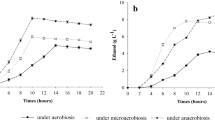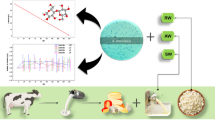Abstract
The fermentation of lactose byKluyveromyces fragilis is an exothermic reaction in which heat is released, resulting in a rise in reactor temperature. A heat balance was performed on a 5-L batch reactor used for single cell protein (SCP) production to determine the portions of cheese whey lactose used for energy and growth. On the average, about 88% of lactose was used for growth, and 12% was used for energy. The lactose consumed during the lag and stationary phases was used mostly for cell endogenous growth and respiration, whereas that consumed during the exponential growth phase was used for cell multiplication and energy. The heat released varied from 6.5 to 8.9 kJ/g cell. Because of the proper design of the fermenter, the temperature of the medium did not rise above 33°C; thus, no cooling system was needed.
Similar content being viewed by others
References
Jelen, P. and LeMarguer, M. (1974), Feasibility evaluation of industrial processing of cheese whey. ASAE paper No. 74-6503, St. Joseph, Michigan, IL.
Singh, R. K. and Ghaly, A. E. (1984), Single-cell protein production from cheese whey. ASAE Paper No. 84-6528, St. Joseph, Michigan, IL.
Webb, B. H., Johnson, A. H., and Alford, J. A. (1974),Fundamentals of Dairy Chemistry, 2nd ed., AVI, Westport, CT.
Webb, B. H. and Whitter, E. O. (1970),By-Products From Milk, AVI, Westport, CT.
Singh, R. K. and Ghaly, A. E. (1985), Feasibility of cheese whey processing for production of food and feed supplement. CSAE Paper No. 85-504. Ottawa, Ont.
Litchfield, H. J. (1979), Production of single-cell protein for use in food or feed,Microbial Technology, Academic, New York.
Nester, E. W., Roberts, C. E., Pearsall, N. N., and McCarthy, B. J. (1978),Microbiology, 2nd Ed., Holt Rinehart and Winston, New York.
Luria, S.E. (1960), The bacteria protoplasm: composition and organisation,The Bacteria, Gunsalus, I. C. and Stainer, R. Y., eds., Academic, New York.
Reisman, A. B., Gore, J. H., and Day, J. T. (1968), The design of a pilot plant for batch and continuous Fermentation.Chem. Eng. Progress Symp. Series 64(86), 26–36.
Weast, R. C. (1988),Handbook of Chemistry and Physics, 69th Ed., Chemical Rubber Company, Cleveland, OH.
Perry, R. H. and Green, D. (1984),Perry’s Chemical Engineer's Handbook, 6th Ed., Macgraw-Hill, New York.
Ben-Hassan, R. M., Ghaly, A. E., and Mansour, M. H. (1991), A computer based pH measurement and control system for fermentation processes.App. Biochem. Biotechnol. J. 30, 233–245.
APHA (1985),Standard Methods for the Examination of Water and Wastewater. American Public Health Association, Washington, DC.
Messer, J. W., Behney, H. M., and Leudecke, L. O. (1985), Microbiological count methods,Standard Methods for the Examination of Dairy Products, 15th Ed., Richardson, G. H., ed., American Public Health Association, Washington, DC.
Ghaly, A.E., Ben-Hassan, R. M., and Mansour, M. H. (1991), Effect of pH control on the growth and survival ofKluyveromyces fragilis in cheese whey under aerobic condition.App. Biochem. Biotechnol. J. (in press).
Bernstein, S., Tzeng, C. H., and Sisson, D. (1977), The commercial fermentation of cheese whey for the production of protein and/or alcohol.Biotechnol. Bioeng. Symp. 7, 1–9.
Bernstein, S. and Everson, T. C. (1973), Protein production from acid whey via fermentation. Proceedings of the National Symposium on Food Process Waste, 4th Environmental Protection Agency Technology Series, No. EPA66012-73-031, College Park, MD.
Wasserman, A. E. (1960), The rapid conversion of whey to yeast.Dairy Eng. 77, 374–379.
Alvarez, J. and Ricano, J. (1979), Modeling and optimal control of a SCP fermentation process.Biotechnol. Bioeng. Symp. 9, 149–154.
Vananuvat, P. and Kinsella, J. E. (1975), Production of yeast protein from crude lactose bySaccharomyces fragilis: batch culture and continuous culture studies.J. Food Sci. 40(2), 336–341, 823-825.
Mahmoud, M. M. and Kosikowski, F. V. (1982), Alcohol and single cell protein production byKluyveromyces in concentrated whey permeates with reduced ash.J. Dairy Sci. 65, 2082–2087.
Burgess, K. J. (1977), Production of yeast protein from lactose permeate in a tower fermenter.J. Food Sci. Technol. 1, 107–115.
Porges, N. (1953), Yeast: a valuable product from wastes.J. Chem. Education 30(11), 562–565.
Longmuir, I. S. (1954), Respiration rate of bacteria as a function of oxygen concentration.Biochemistry 57(1), 81–87.
Winzler, K. J. (1941), The respiration of baker yeast at low oxygen tension.J. Cellular and Comparative Physiol. 17(3), 264–271.
Ghaly, A. E., Kok, R., and Ingrahm, J. M. (1989), Growth rate determination of heterogeneous microbial population in swine manure.App. Biochem. Biotechnol. 22, 59–77.
Maxon, W. D. and Johnson, M. J. (1953), Aeration studies on propagation of baker’s yeast.Ind. Eng. Chem. 45, 2554–2560.
Hixon, A. W. and Gaden, E. L. Jr. (1950), Oxygen transfer in submerged fermentation.Ind. Eng. Chem. 42, 1792–1801.
Strohm, J., Dale, R. F., and Peppier, H. J. (1959), Polarographic measurement of dissolved oxygen in yeast fermentation.App. Microbiol. 7(4), 235–238.
Litchfield, H. J. (1983), Single-cell proteins.Science 219(2), 740–746.
Delaney, R. A. M., Kennedy, R., and Waley, B. D. (1975), Composition ofSaccharomyces fragilis biomass grown on lactose permeate.J. Sci. Food Agriculture 26(12), 1177–1186.
Ghaly, A. E. and Singh, R. K. (1989), Pollution potential reduction of cheese whey through yeast fermentation.App. Biochem. Biotechnol. 22(3), 181–203.
ASHRAE (1989),Fundamentals. American Society of Heating, Refrigeration and Air Conditioning Engineers, Atlanta, GA.
Holman, J. P. (1990),Heat Transfer, 7th Ed., McGraw-Hill, New York.
Stockar, U. V. and Birou, B. (1989), The heat generated by yeast cultures with a mixed metabolism in the transition between respiration and fermentation.Biotechnol. Bioeng. 34, 86–101.
Author information
Authors and Affiliations
Rights and permissions
About this article
Cite this article
Ben-Hassan, R.M., Ghaly, A.E. & Ben-Abdallah, N. Metabolism of cheese whey lactose by kluyveromyces fragilis for energy and growth under batch condition. Appl Biochem Biotechnol 33, 97–116 (1992). https://doi.org/10.1007/BF02950780
Received:
Accepted:
Issue Date:
DOI: https://doi.org/10.1007/BF02950780




